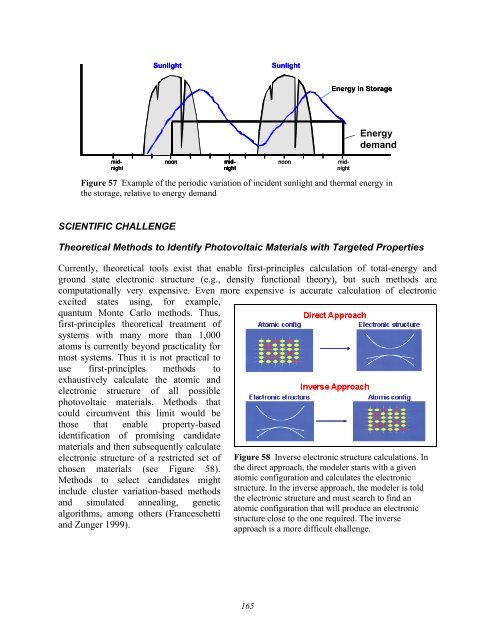Basic Research Needs for Solar Energy Utilization - Office of ...
Basic Research Needs for Solar Energy Utilization - Office of ...
Basic Research Needs for Solar Energy Utilization - Office of ...
Create successful ePaper yourself
Turn your PDF publications into a flip-book with our unique Google optimized e-Paper software.
midnight<br />
Sunlight<br />
noon midmidnightnight<br />
165<br />
Sunlight<br />
noon midnight<br />
<strong>Energy</strong> in Storage<br />
<strong>Energy</strong> Output<br />
demand Power<br />
Figure 57 Example <strong>of</strong> the periodic variation <strong>of</strong> incident sunlight and thermal energy in<br />
the storage, relative to energy demand<br />
SCIENTIFIC CHALLENGE<br />
Theoretical Methods to Identify Photovoltaic Materials with Targeted Properties<br />
Currently, theoretical tools exist that enable first-principles calculation <strong>of</strong> total-energy and<br />
ground state electronic structure (e.g., density functional theory), but such methods are<br />
computationally very expensive. Even more expensive is accurate calculation <strong>of</strong> electronic<br />
excited states using, <strong>for</strong> example,<br />
quantum Monte Carlo methods. Thus,<br />
first-principles theoretical treatment <strong>of</strong><br />
systems with many more than 1,000<br />
atoms is currently beyond practicality <strong>for</strong><br />
most systems. Thus it is not practical to<br />
use first-principles methods to<br />
exhaustively calculate the atomic and<br />
electronic structure <strong>of</strong> all possible<br />
photovoltaic materials. Methods that<br />
could circumvent this limit would be<br />
those that enable property-based<br />
identification <strong>of</strong> promising candidate<br />
materials and then subsequently calculate<br />
electronic structure <strong>of</strong> a restricted set <strong>of</strong><br />
chosen materials (see Figure 58).<br />
Methods to select candidates might<br />
include cluster variation-based methods<br />
and simulated annealing, genetic<br />
algorithms, among others (Franceschetti<br />
and Zunger 1999).<br />
Figure 58 Inverse electronic structure calculations. In<br />
the direct approach, the modeler starts with a given<br />
atomic configuration and calculates the electronic<br />
structure. In the inverse approach, the modeler is told<br />
the electronic structure and must search to find an<br />
atomic configuration that will produce an electronic<br />
structure close to the one required. The inverse<br />
approach is a more difficult challenge.
















